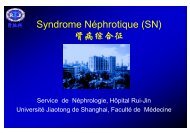The impact of rehabilitation on chronic whiplash
The impact of rehabilitation on chronic whiplash
The impact of rehabilitation on chronic whiplash
Create successful ePaper yourself
Turn your PDF publications into a flip-book with our unique Google optimized e-Paper software.
134 J.-M. Gosnold<br />
Joint dysfuncti<strong>on</strong>, such as cervical facet syndrome,<br />
is a comm<strong>on</strong> manifestati<strong>on</strong> <str<strong>on</strong>g>of</str<strong>on</strong>g> faulty movement<br />
patterns. In 1964, Mennel 27 defined joint<br />
dysfuncti<strong>on</strong> as ‘‘loss <str<strong>on</strong>g>of</str<strong>on</strong>g> joint-play movement that<br />
cannot be produced by voluntary muscles’’. It has<br />
been theorised that a loss in joint play can lead to<br />
pain, producing reflex effects <strong>on</strong> the surrounding<br />
muscles. 24 <str<strong>on</strong>g>The</str<strong>on</strong>g> result is that certain muscles<br />
become hypert<strong>on</strong>ic, whilst others become neurologically<br />
inhibited. This imbalance leads to local dysfuncti<strong>on</strong><br />
in muscle and joint interacti<strong>on</strong>, causing<br />
faulty movement patterns. <str<strong>on</strong>g>The</str<strong>on</strong>g>refore, it can be<br />
hypothesised that, to address <strong>on</strong>ly the joint dysfuncti<strong>on</strong><br />
through manipulati<strong>on</strong>, will <strong>on</strong>ly create a<br />
temporary increase in moti<strong>on</strong>. If the muscle imbalance<br />
and faulty movement patterns are not<br />
addressed, this c<strong>on</strong>tinued dysfuncti<strong>on</strong> would prevent<br />
the joint from maintaining normal functi<strong>on</strong>.<br />
This cycle <str<strong>on</strong>g>of</str<strong>on</strong>g> perturbing factors is comm<strong>on</strong>ly seen in<br />
chr<strong>on</strong>ic neck pain patients both <str<strong>on</strong>g>of</str<strong>on</strong>g> n<strong>on</strong>-traumatic<br />
and traumatic origin. To break this cycle requires a<br />
‘three-pr<strong>on</strong>ged’ approach. Firstly, to reduce joint<br />
dysfuncti<strong>on</strong> via manipulati<strong>on</strong>; sec<strong>on</strong>dly, to restore<br />
normal muscle balance and functi<strong>on</strong> and, thirdly, to<br />
re-educate the body’s movement patterns via <str<strong>on</strong>g>rehabilitati<strong>on</strong></str<strong>on</strong>g>.<br />
Joint manipulati<strong>on</strong> is performed to restore jointplay<br />
and is thought to work by releasing entrapped<br />
synovial folds or plica, relaxing hypert<strong>on</strong>ic muscles<br />
and disrupting articular or periarticular adhesi<strong>on</strong>s.<br />
28 Muscle dysfuncti<strong>on</strong>, particularly in the case<br />
<str<strong>on</strong>g>of</str<strong>on</strong>g> trigger points, can become a significant cause <str<strong>on</strong>g>of</str<strong>on</strong>g><br />
pain. This pain is <str<strong>on</strong>g>of</str<strong>on</strong>g>ten resp<strong>on</strong>sible for antalgic<br />
posture or compensatory muscular facilitati<strong>on</strong>. 29<br />
Treatment includes s<str<strong>on</strong>g>of</str<strong>on</strong>g>t tissue massage, trigger<br />
point therapy and both passive (e.g. PIR) and active<br />
(e.g. proprioceptive neuromuscular facilitati<strong>on</strong><br />
(PNF)) stretching techniques.<br />
Rehabilitati<strong>on</strong> via sensorimotor training and cervical<br />
stabilisati<strong>on</strong> produces several key benefits to<br />
the chr<strong>on</strong>ic neck pain patient. Firstly, the efficiency<br />
and effectiveness <str<strong>on</strong>g>of</str<strong>on</strong>g> comm<strong>on</strong> movement patterns<br />
involving the cervical spine and shoulder girdle are<br />
improved. This makes daily tasks less demanding,<br />
both in terms <str<strong>on</strong>g>of</str<strong>on</strong>g> c<strong>on</strong>scious effort <strong>on</strong> the patient’s<br />
part and by preventing over recruitment <str<strong>on</strong>g>of</str<strong>on</strong>g> compensatory<br />
muscles. In <strong>whiplash</strong>, the cervical flexi<strong>on</strong><br />
pattern is particularly important, being tested<br />
supine to work against gravitati<strong>on</strong>al resistance.<br />
<str<strong>on</strong>g>The</str<strong>on</strong>g> correct and incorrect cervical flexi<strong>on</strong> movement<br />
patterns are shown in Table 2. 30 Improving the<br />
speed and accuracy <str<strong>on</strong>g>of</str<strong>on</strong>g> the eye—head—neck—upper<br />
extremity reflexes maximises neurological integrati<strong>on</strong><br />
and c<strong>on</strong>trol, providing a protective functi<strong>on</strong> for<br />
the system as a whole. Strengthening key muscle<br />
groups acts to improve the stability <str<strong>on</strong>g>of</str<strong>on</strong>g> the cervical<br />
Table 2 Correct and incorrect cervical flexi<strong>on</strong><br />
movement patterns. 30<br />
Correct flexi<strong>on</strong> Incorrect flexi<strong>on</strong><br />
C<strong>on</strong>trolled movement Jaw juts forward<br />
Chin tucked in Hyperextensi<strong>on</strong> at<br />
Balanced activati<strong>on</strong><br />
<str<strong>on</strong>g>of</str<strong>on</strong>g> both deep neck<br />
flexors and<br />
sternocleidomastoid<br />
(SCM) muscles<br />
No muscle fatigue<br />
(‘‘shuddering’’)<br />
cervico-cranial juncti<strong>on</strong><br />
Weak deep neck flexors<br />
with str<strong>on</strong>g SCM<br />
Muscle fatigue leading to<br />
unsustainable movement<br />
spine, preventing extreme end ranges <str<strong>on</strong>g>of</str<strong>on</strong>g> moti<strong>on</strong><br />
that can lead to l<strong>on</strong>g-term complicati<strong>on</strong>s.<br />
Disturbance <str<strong>on</strong>g>of</str<strong>on</strong>g> eye-head-neck co-ordinati<strong>on</strong> and<br />
oculomotor reflexes resulting from cervical trauma<br />
has been well documented. 31 <str<strong>on</strong>g>The</str<strong>on</strong>g> cervical spine<br />
has an extremely high afferent input into the Central<br />
Nervous System (CNS), particularly from the<br />
muscle spindles <str<strong>on</strong>g>of</str<strong>on</strong>g> the intrinsic muscle groups. This<br />
informati<strong>on</strong> is used to mediate various locomotor<br />
activities, with the most important c<strong>on</strong>necti<strong>on</strong><br />
being with the vestibular nucleus. This pathway<br />
mediates both the activity <str<strong>on</strong>g>of</str<strong>on</strong>g> individual muscles,<br />
and the overall posture, balance and stability<br />
mechanisms. 24 <str<strong>on</strong>g>The</str<strong>on</strong>g>refore, cervical dysfuncti<strong>on</strong><br />
can disrupt these mechanisms causing functi<strong>on</strong>al<br />
compromise within the CNS. <str<strong>on</strong>g>The</str<strong>on</strong>g> T<strong>on</strong>ic Neck Reflex<br />
(TNR) c<strong>on</strong>stitutes <strong>on</strong>e <str<strong>on</strong>g>of</str<strong>on</strong>g> the most significant<br />
reflexes that can be affected by cervical dysfuncti<strong>on</strong>.<br />
In normal circumstances, this reflex acts to<br />
distribute muscle t<strong>on</strong>e throughout the locomotor<br />
system as a result <str<strong>on</strong>g>of</str<strong>on</strong>g> cervical movements. 32 <str<strong>on</strong>g>The</str<strong>on</strong>g><br />
TNR is usually quiescent, <strong>on</strong>ly manifesting itself<br />
when a high degree <str<strong>on</strong>g>of</str<strong>on</strong>g> skill or power is required.<br />
Fukushima and Hinoki 33 showed that the TNR might<br />
also manifest in the presence <str<strong>on</strong>g>of</str<strong>on</strong>g> cervical dysfuncti<strong>on</strong><br />
and pain, the result being that certain trunk<br />
and extremity muscles became either hypert<strong>on</strong>ic<br />
or inhibited.<br />
Compromise to the vestibular nucleus also<br />
affects balance, with many patients who have cervical<br />
dysfuncti<strong>on</strong> also reporting vertigo or dysequilibrium.<br />
<str<strong>on</strong>g>The</str<strong>on</strong>g> adaptati<strong>on</strong> required in overcoming<br />
these symptoms places further strain <strong>on</strong> the locomotor<br />
system, lowering the margin <str<strong>on</strong>g>of</str<strong>on</strong>g> error in the<br />
system and predisposing to the susceptibility <str<strong>on</strong>g>of</str<strong>on</strong>g><br />
injury and dysfuncti<strong>on</strong> in other areas <str<strong>on</strong>g>of</str<strong>on</strong>g> the body.<br />
<str<strong>on</strong>g>The</str<strong>on</strong>g> Saccade and Smooth Pursuit oculomotor<br />
reflexes are also affected. 34 Muscle imbalances in<br />
the cervical spine, particularly in the cervical rotators<br />
(SCM, upper trapezius, splenius capitus and





